‘Lucid’ dreamers could solve mysteries about sleeping minds
Dreams are one of the most universal yet poorly understood human experiences

Lucid dreamers are like astronauts exploring other worlds. But instead of trekking through outer space, they trek through the inner spaces created by their sleeping minds.
Natalia Misintseva/iStock/Getty Images Plus; adapted by L. Steenblik Hwang
When Christopher Mazurek realizes he’s dreaming, it’s always the small stuff that tips him off.
The first time it happened, Mazurek was a freshman in college. In the dream, he found himself in a campus dining hall. It was winter, but Mazurek wasn’t wearing his favorite coat. “I realized that, okay, if I don’t have the coat, I must be dreaming,” Mazurek says.
That epiphany rocked the dream like an earthquake. “Gravity shifted, and I was flung down a hallway that seemed to go on for miles,” he says. “My left arm disappeared, and then I woke up.”
Gravity shifted, and I was flung down a hallway that seemed to go on for miles.… My left arm disappeared, and then I woke up.
Christopher Mazurek
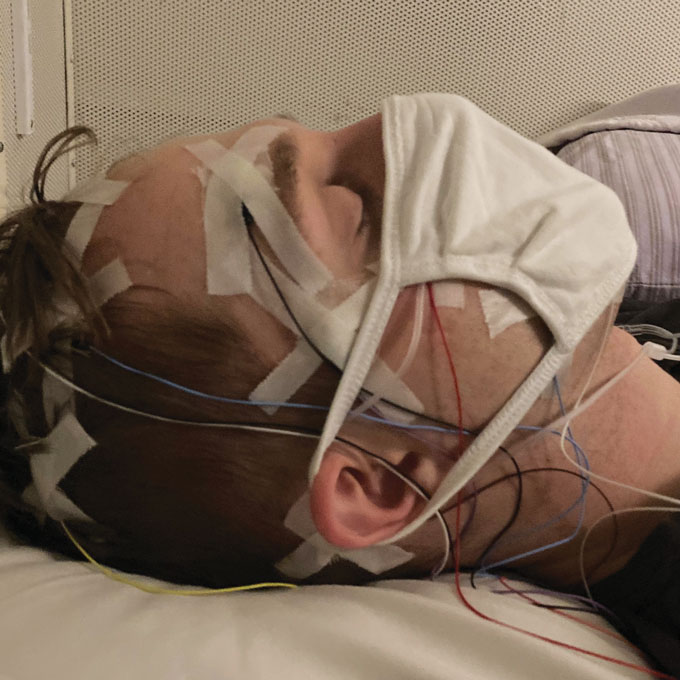
The experience of knowing you’re in a dream while still asleep is called “lucid dreaming.” Most people rarely, if ever, lucid dream. But many enthusiasts have practiced techniques to become self-aware in their sleep. Some can even control aspects of their dream selves and settings.
Mazurek, 24, has gotten better at molding his lucid dreams since that first whirlwind experience. Sometimes he uses them to try flying or say hi to dream versions of deceased family members.
Other lucid dreamers poke around their subconscious minds using their personal virtual realities. Or they can feast on junk food without real-world consequences. Now scientists have a new job for lucid dreamers: to explore their dreamscapes and report out their experiences in real time.
Dream research typically relies on asking people about their dreams after they wake up. But people often wake with only spotty, distorted memories of their dreams. And they can’t customize their dreams for scientific studies.
“The special thing about lucid dreaming is that you can get even closer to dream content and in a much more controlled and systematic fashion,” says Martin Dresler. He’s a neuroscientist in the Netherlands. He works at the Donders Institute in Nijmegen.
Some lucid dreamers can do tasks and send signals to researchers in the waking world while they’re still asleep. In this way, they become sort of like astronauts “radioing” ground control as they’re completing missions. Only instead of exploring outer space, these dreamers are exploring the inner space of their slumbering minds.
So far, tests in very small groups of lucid dreamers have helped reveal how people experience dreams. They’ve also offered insight into what people are capable of doing while dreaming.
With more lucid dreamers, scientists hope to probe how sleeping brains build their elaborate, often bizarre plots and settings. Lucid dreams might even offer clues about how dreams contribute to creativity, processing emotions or other mental tasks.
And that could help solve the grand mystery of why we dream.

Proving lucid dreams
Tales of lucid dreams date back to ancient times. But these self-aware dreams still seem rare. Only about half of people say they’ve ever had a lucid dream. A mere one in 100 or so say they lucid dream multiple times a week.
People have used a range of techniques to boost their odds of lucid dreaming. One method is to tell yourself over and over before bed that you’ll have a lucid dream. Another is to ask yourself if you’re awake several times a day. (The idea is to get into a routine of checking whether you’re awake. That way, if you do it out of habit in a dream, you might realize you’re asleep.)
But those practices don’t guarantee a lucid dream.
Lucid dreams are so elusive that, for a while, not all scientists were sure they ever happened. But experiments in the last few decades have offered proof that some sleepers can be self-aware.
When a dreamer sweeps their gaze all the way left, then all the way right, their eyes in real life may match those movements behind their closed eyelids. Electrodes near a person’s eyes can detect those motions. Such big, sweeping movements stand out from the smaller eye motions typical of REM sleep. (REM stands for rapid eye movement.) REM sleep is the stage when most lucid dreams take place.
This gives dreamers a crude way to signal they’ve become lucid. Or send other messages to the outside world. For instance, they can tell scientists before sleep that when they become lucid in a dream, they’ll look left-right-left-right. Researchers tracking the electrodes near the sleeper’s eyes can then spot those signals.
Researchers also can check that the person giving those eye signals really is asleep. How? One way is to look at their brain waves. Another is to measure their muscle activity with other electrodes. “During REM sleep, the entire body is paralyzed,” Dresler says. It’s not possible to fake that kind of stillness when awake.
Just getting started
Scientists are just starting to harness lucid dreamers’ ability to signal the waking world. Lucid-dream research is “one of the cutting-edge areas of dream study,” says Tore Nielsen. This neuroscientist works at the Center for Advanced Research in Sleep Medicine. That’s in Montreal, Quebec.
One team deployed experienced lucid dreamers to find out whether dream imagery is more like real-life visuals or imagined ones. While asleep, six lucid dreamers moved their thumbs in either a circle or a line. The dreamers traced that motion with their eyes. They did same task while awake with their eyes open — and in their imaginations with their eyes closed.
People’s gazes panned in jerky motions when they tracked the imagined movements. But in dreams, people’s eyes tracked thumb movements smoothly — just as they did in real life.
Notes Benjamin Baird, “It’s been debated really all the way back to the ancient Greeks, are dreams more like imagination?” Or are they more like perception? “The smooth tracking data suggests,” he says, “the imagery is more like perception.” Baird is a psychologist and neuroscientist at the University of Texas at Austin. He and his colleagues shared the thumb-tracking study in 2018.
Studies like this, with a few expert lucid dreamers, offer a taste of what dream-stronauts could teach us. But any findings based on just a handful of people must be viewed with caution, adds Michelle Carr. She’s a neuroscientist at the Center for Advanced Research in Sleep Medicine. She says: “It needs to be studied in bigger samples.”
That means finding — or creating — more expert lucid dreamers.
Eyes on eye movements
A person’s eyes can smoothly track left and right movements when they are awake (left) or in a lucid dream (middle). But when someone closes their eyes and tries to imagine tracking that motion, their eyes pan in small jumps (right). This hints that in some respects, lucid dreams are experienced more like waking perception than imagination.
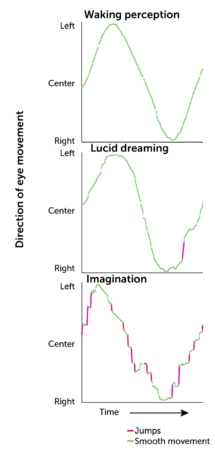
Recipe for a lucid dream
There are a few common things people do to up their chances of lucid dreaming. Besides checking if they’re awake throughout the day and telling themselves to lucid dream before bed, some do “wake back to bed.” This involves waking up super early, staying up for a while, then getting more shuteye.
That jolt of alertness right before tumbling back into REM sleep may help people become lucid in their dreams.
Still, data on the effectiveness of these techniques are pretty murky, Baird says.
In 2020, Carr was part of a team that coaxed 14 of 28 nappers to become lucid in the lab. That included three people who’d never lucid dreamed before.
Before falling asleep, the nappers learned to associate a cue — such as a series of beeps — with being self-aware. Hearing the same sound again while sleeping reminded them to become lucid.
This method “is kind of a shortcut” to lucid dreaming, says Ken Paller. It doesn’t require a lot of the mental training — or weird sleep schedules — that some other techniques do. Paller is a neuroscientist at Northwestern University in Evanston, Ill. His team has used sound cues to help sleepers become lucid and do dream tasks for experiments.
Another way to get more sleepers to lucid dream in the lab is to recruit people from a special slice of the population. In particular, people with narcolepsy. This condition is known for making people fall asleep a lot during the day. But narcolepsy patients seem to experience another side effect, too.
“They’re just champions at lucid dreams,” says Isabelle Arnulf. She’s a sleep neurologist at Pitie-Salpetriere University Hospital in Paris.
In 2018, Arnulf’s team shared a study in which 18 of 21 narcolepsy patients became lucid during lab naps. Those are impressive numbers. Still, some lucid nappers couldn’t control their dreams well enough to complete their assignment. They were meant to do something in a dream that made them briefly stop breathing. Swim underwater, for instance, or speak.
One napper said after waking that they’d simply forgotten to stop breathing while diving off a cliff. Another said they tried to speak but couldn’t.
Lucid dreamers often forget they’re dreaming and go back to having normal dreams. Many also struggle to control their dreams.
In one 2020 study, people were told to fill a dream room with objects, such as a clock or rubber snake. For some dreamers, the clock spun wildly or the snake slithered away. In another study, lucid dreamers were asked to practice throwing darts. They, too, ran into problems. Some said they had only pencils to throw in their dream, or were pelted with darts by a nasty doll.
“It’s a lot harder than just passively lucid dreaming in your bed,” says Mazurek. He has participated in several lucid-dream studies at Northwestern. “You realize, ‘OK, I have to stabilize the dream. I have to remember what the task is. I have to do the task without the dream falling apart.’ ”
Despite these challenges, lucid-dream studies are forging ahead — and fast. In fact, a crew of dreamfarers including Mazurek recently embarked on their most ambitious mission yet.
Real-time dream science
In most lucid-dream studies so far, researchers assigned people a task to do in their dreams before they fell asleep. Then, the scientists sat back and watched what happened.
But what if researchers could ask people what they were doing, seeing and feeling — and get that response mid-dream? People’s moment-to-moment responses could paint the realm of dreams in sharper detail than ever before.
For instance, Nielsen says, researchers might ask what foods taste like or what noises sound like in dreams. Such details could reveal how closely dreams mimic the real world. And that might offer insight into how sleeping brains render dreams.
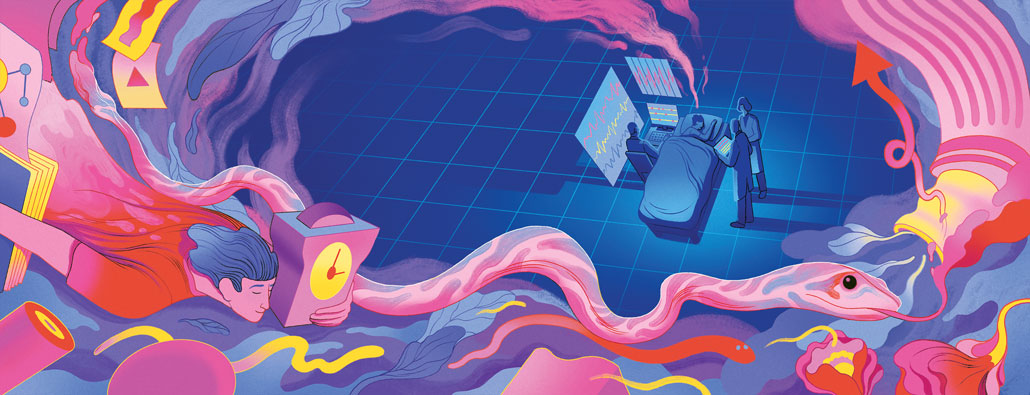
Karen Konkoly, meanwhile, hopes to assign sleepers tasks mid-dream. She’s a neuroscientist who works with Paller at Northwestern. Imagine, she says, that researchers want to know whether dreams help people with creative problem solving.
If dreamers are assigned a problem before sleep, they’re liable to think it over as they nod off. “Even if it feels like the lucid dream, maybe it’s really the time as you’re falling asleep that helped you solve the problem,” says Konkoly. Telling someone to solve a puzzle when they’re already dreaming could better isolate how useful dreams are for helping the brain tackle such problems.
There’s a whole bunch of theories about why people dream. Maybe they help us practice skills. Or tap into creativity. Or process memories or emotions. “If you can’t control the dream in real time and then study the outcome, then you’ll never know … if the dream is really doing anything,” Konkoly says.
A few years ago, she, Arnulf, Dresler and others decided to find out if dreamers could receive and respond to input from the outside world.
Thirty-six people took snoozes in the lab. Once sleepers signaled that they were lucid, researchers gave them yes-or-no questions or math problems. Some questions were spoken. Others were conveyed through flickering lights. Before falling asleep, dreamers were told to answer whatever questions they received with left-right eye signals or by smiling or frowning. (Someone smiling in a dream may not make that expression in real life. But electrodes on the face can register tiny corresponding muscle twitches.)
On 158 occasions, scientists questioned dreamers who’d signaled they were lucid. Most times, they got no response. But 29 total correct responses came from six different people. Those six ranged from newbies to frequent lucid dreamers, including Mazurek. He heard scientists’ questions while dreaming he was in a Legend of Zelda game.
Answering questions during a dream
While dreaming, Christopher Mazurek signaled the outside world by sweeping his eyes left and right. Electrodes on his face recorded those motions. On the graph, eye motions that show Mazurek is lucid appear as three big up-down sweeps. Eye signals answering “2” appear as two big up-down sweeps. Mazurek made those eye movements in response to researchers’ simple math question, “What is 8 minus 6?”
Lucid dreamer’s eye movements during a mid-dream conversation
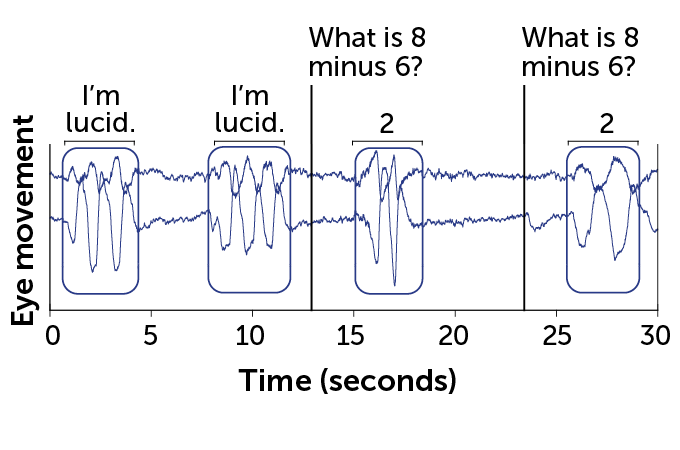
When Konkoly first saw someone correctly answer a question in their sleep, “my first reaction was to not believe it.” But other sleep experts confirmed the dreamers were in REM sleep when they replied. The team detailed the results in a 2021 issue of Current Biology.
“I was astonished,” says Robert Stickgold. This neuroscientist at Harvard Medical School in Boston, Mass., studies dreams (although not lucid ones). “I had no question but that these people are in fact listening and are in fact having lucid dreams at the time of the communication,” he says. “That opens up all sorts of possibilities.”
Arnulf and others have since asked lucid dreamers to smile or frown as their dreams became more or less pleasant. The goal is to understand how dreamers experience emotions.
Another study, not yet published, tracked when lucid dreamers answered or ignored researchers’ questions. The team wanted to see how people tuned in and out of the real world while dreaming. Knowing which signals break the dream-reality barrier could help uncover how the brain unplugs from the outside world during sleep.
Brain clues to lucid dreams
Scientists took fMRI scans of one sleeper’s brain during lucid and nonlucid sleep. Those scans showed that some brain areas (highlighted) may be more active during lucid dreams than during normal sleep.
- The lateral parietal cortex is involved in working memory.
- The dorsolateral prefrontal cortex and frontopolar cortex are involved in working memory and introspection.
- Activity near the temporal cortex may make lucid dreams brighter and more detailed than normal dreams.
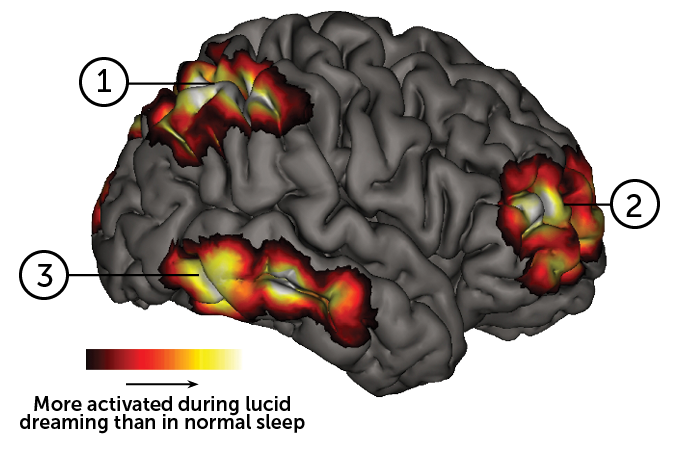
Limits of lucidity
Lucid dreams may be useful tools to study dreams. But they have one major limitation.
“The biggest issue is how far can you push these results to dreaming in general,” Stickgold says. Imagine, for instance, that lucid dreamers get better at a skill by practicing it in their dreams. It’s not clear that people who just happen to have normal dreams about doing those activities — without self-awareness — would get the same rewards. “It’s a little bit like recruiting Major League Baseball players to [help study] how far people can throw balls,” Stickgold says.
Some data suggest lucid dreamers may have access to parts of the brain that normal dreamers don’t. Brain scans of one person’s lucid and nonlucid sleep hint that brain regions linked to self-reflection and memory are more active during lucid dreams.
But researchers like Dresler doubt that lucid and nonlucid dreams are profoundly different. “Lucid dreaming is not a strict all-or-nothing phenomenon,” he says. People often flutter in and out of awareness. “That suggests that lucid and nonlucid dreaming are in principle something very similar,” he says. “Not two completely different animals.”
Perhaps lucidity affects some aspects of the dream experience but not all of them, Baird adds. In terms of how dreams look, he says, “it would be very, very surprising if it was somehow completely different when you become lucid.”
More brain scans taken during people’s lucid and nonlucid dreams could help settle these questions. But even if lessons from lucid dreams can’t be applied to all dreams, Nielsen still thinks they’re worth studying.
“It is a type of consciousness that has intrigued and amused people for centuries,” he says. “It would be important for science to understand how and why humans have this extraordinary capacity for intentional world simulation.”







